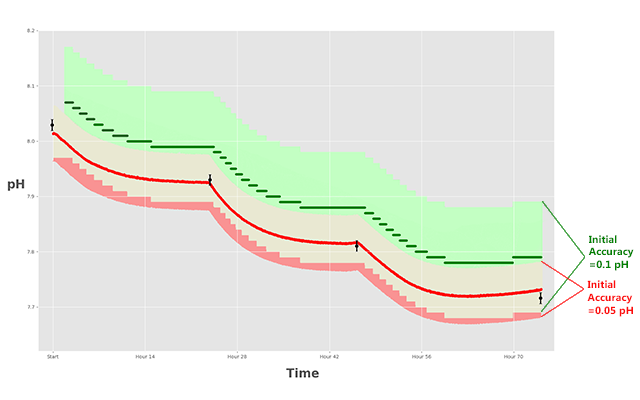These data came from two different types of pH sensors – a SeapHOx V2 with an ISFET pH sensor (red) and the HC-pH glass electrode pH sensor installed on a HydroCAT-EP (green). The four black bars in the figure above mark validation samples from a spectrophotometer, with error bars denoting the ±0.01 pH accuracy of that method.
These results highlight two noteworthy differences between each sensor technology:
- Initial Accuracy: the SeapHOx V2 has an initial accuracy of ±0.05 pH or better, while most glass electrode pH sensors (the HydroCAT-EP included) have an initial accuracy of ±0.1 pH. The figure above demonstrates each sensor’s accuracy with the shaded area around each line (light green = HC-pH accuracy, light red = SeapHOx V2 accuracy, yellow= overlap). Based on the validation samples, both pH sensors were reporting data within their accuracy specifications, but the SeapHOx V2 was clearly more accurate from start to finish.
- Sampling resolution: the “stepwise” changes in the HC-pH data are the result of lower resolution. The sensor is unable to resolve changes lower than 0.01 pH, so small changes in pH aren’t recorded until a large enough change can be detected. The SeapHOx V2 is able to resolve small changes of up to 0.004 pH, resulting in smooth lines as pH drops.
While the data from the ISFET pH sensor are superior in accuracy, resolution, and stability, there are still many applications where glass electrode sensors such as the one integrated with the HydroCAT-EP are sufficient. However, when you need top of the line pH for long-term moored deployments, an instrument using an ISFET pH sensor (SeaFET V2, SeapHOx V2, or Deep SeapHOx V2) is necessary.

